|
Regency
TR Series Transistor Radios
TR-1 The First!
|
|
Consumer Reports Report on the TR-1
from April 1955
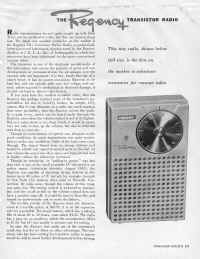
click image for larger view!
|
|
Consumer Reports Report on the TR-1
April 1955 |
| |
|
Radio manufacturers haven't quite caught up with Dick
Tracy and his wristwatch. radio, but they are coming along fast. The
latest and smallest contender on the market is the Regency TR-1
Transistor Pocket Radio, a pocket-sized, battery-powered instrument,
manufactured by the Regency division of I. D. E. A., Inc., of
Indianapolis, in which tiny transistors have been substituted for the more
conventional vacuum tubes.
The transistor is one of the electronic wonderworks of
the mid-century and carries the promise of great and new developments in
communications. Its advantages over the vacuum tube are important: it is
tiny, barely the size of a match head; it has no power-consuming filaments
to be kept hot, and can operate with very low voltage and cur- rent;
unless exposed to mechanical or electrical damage, it should-at least in
theory-last forever.
If you must have the smallest available radio then the Regency
has perhaps realized some of the transistor's potentialities. Its size
is 5x3xl3/8 inches; its weight, 121/2 ounces. But if your demands on a
radio are more exacting than mere portability, then the Regency misses the
mark. In a quiet room, speech can be heard easily through the Regency, even
when the volume control is not at its highest. But on a noisy street or at
a busy beach, it would be necessary not only to turn up the volume, but
also to hold the unit close to your ear.
Though its transmission of speech was adequate under
good conditions, its music transmission was quite unsatisfactory under any
conditions. Little of the bass tones came through. The signal hissed even
on strong stations and tended to whistle and squeal at several spots on
the dial. At low volume the sound was thin, tinny and high-pitched and at
higher volume the distortion increased.
Though its sensitivity, or "pulling-in power,' was
less than that of any of the small portables CU discussed in an earlier
report (CONSUMER REPORTS,
August 1953), the
Regency was capable of receiving strong stations at distances up to 40
miles: a CU test set, for example, brought in New York City stations when
used in Norwalk, Connecticut, 40 miles away, though the volume at this
range was quite low. The tuning control is awkward to manipulate, and the
on-off switch on the volume control does not have a positive snap-off; it
would be easy to leave the unit turned on inadvertently and so waste the
battery.
The toy-like novelty of the Regency does not,
however, come at a toy-like price; at $49.95, it is on the expensive side
for a portable. The single battery, which has a playing life of about 20
to 30 hours, costs about $1.25. The radio has a plug for an earphone,
which the manufacturer offers at $7.50, but CU was unable to procure one
for testing.
In sum, the Regency has made use of the
transistors small size, but the set offers no other advantages. The
consumer who has been waiting for transistor radios to appear would do
well to await further developments before buying.
|
|
"THE" Christmas gift for
1955!
Liberty Music Shops ad in New Yorker
magazine
December 3, 1955 p.210.
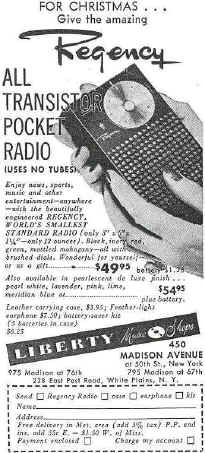
click image for larger view!
|
Regency TR-1G
A slight modification
of the TR-1, the TR-1G's main change is the dial, which is now ribbed and
colored to complement the case. Copper dial accents were always
used, and the dial color is white in all except black TR-1Gs, which have
black dials. The TR-1G was also $10 less expensive than the TR-1 as
noted in the ad below.
The TR-1G was issued later
than the TR-1 in 1956. The TR-1G we have in the museum's collection
was owned since new by Ron Lubman of Woodmere New York. All these
years he had it carefully put away!
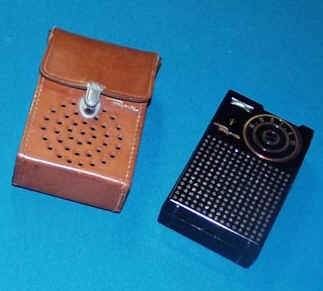

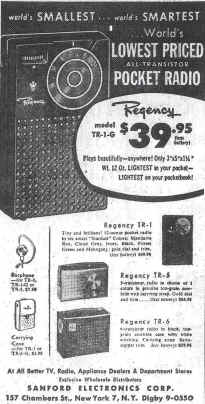
New York Times, Dec. 11, 1956, p.14
click image for larger view!
|
| |

This Regency on display at SMECC was used by Joseph B. Weaver
of I.D.E.A. at the INDY 500, He liked being able to listen to the sportscaster on the radio while watching
the race in front of him!
|
| |
|
|
New Items For Displays!!
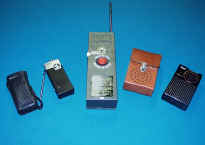
click image for larger view!
The Sony is an automatic tuning FM radio. It has a
clockwork mechanism which rotates the dial and stops at the presence of a
signal The radio is FM only...quite an amazing artifact!
The Regency is a four transistor TR-1G AM radio. It is one
of the first transistor radios marketed.
The CB transceiver was made in 1960 by RME. It free
tunes all CB channels and transmits on channel 7. RME is Radio
Manufacturing Engineers, Inc. of Washington, Ill.
|
|